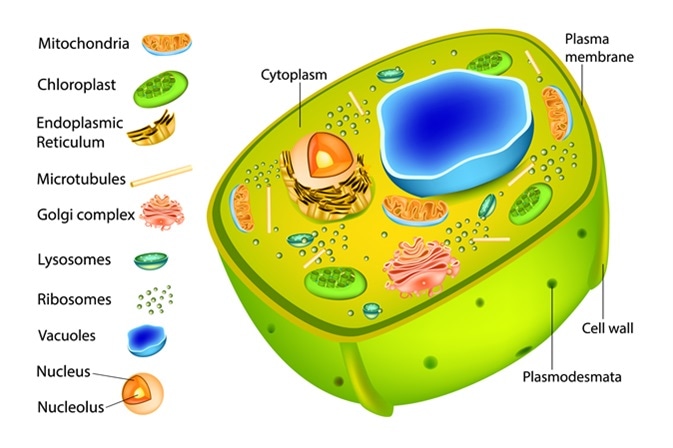One of the most fundamental differences between animal and plant cells is the cell wall – a rigid structure surrounding the plant cells. The cell wall provides strength and structural support, but it also hinders the plant cells from being in direct contact with one another. To overcome this, plants have “plasmodesmata” – intercellular connections which bridge the cytoplasm of two cells together.

Plant Cell Diagram. Image Credit: Sakurra / Shutterstock
Structure
Plasmodesmata is a tube linking one cell to another. Surrounding the open space of the tube is a membrane and running in the center is the desmotubule, which consists of tightly packed endoplasmic reticulum (ER). The ER is continuous between the two cells. Between the desmotubule and the membrane is the cytoplasmic sleeve, where most transfer of molecules occurs. The sleeve contains various structures, such as actin and myosin which provide contractile forces to aid in the transport.
Function
Plasmodesmata facilitate the movement of molecules between cells, ranging from small photosynthetic products to large proteins and mRNA. In vascular tissue, plasmodesmata are crucial for the movement of nutrients. They are also crucial during development because, unlike animal cells, plant cells do not move. The correct expression of genes both temporally and spatially is therefore important. While plant cells, like animal cells, are capable of receptor-ligand interactions to signal other cells, plasmodesmata offer direct contact. In addition, the size of the sleeve differs in different cell types and plant tissues. Plasmodesmata are therefore an active cell component in intercellular transport, during development and in the mature tissue.
Independent Evolution
Plasmodesmata-like structures are present in many multicellular organisms with rigid cell walls, but they appear to have evolved independently in different lineages. This indicates cell connectivity which is critical for multicellularity. As both rigid cell walls and multicellularity have evolved independently several times, true plasmodesmata may also have evolved independently. The plasmodesmata in land plants are not present in their algal ancestors and are thought to have evolved independently. Studies on algae which share a common ancestor with higher plants indicate that the selectivity offered by the ER in plasmodesmata was critical to evolve more complex structures.
Roles of Plasmodesmata During Development
Growth
Using green fluorescent proteins (GFPs), the plasmodesmata aperture was shown to be highest in the shoot meristem (where growth occurs) and significantly lower in the cotyledons (embryonic leaves). This corresponds to adult plants, where connectivity is higher in younger parts and lower in more mature parts, adding further support that plasmodesmata are critical during growth and development.
Defense against infection
Plasmodesmata connectivity can also change in response to certain triggers. Presence of bacterial flagellin and fungal chitin can block plasmodesmata. This is a primary defense against infection, as it effectively seals off the infected cell and blocks passage of the pathogen to other cells.
The goal of current research is to understand how plasmodesmata change their transport abilities spatially and temporally.
Further Reading